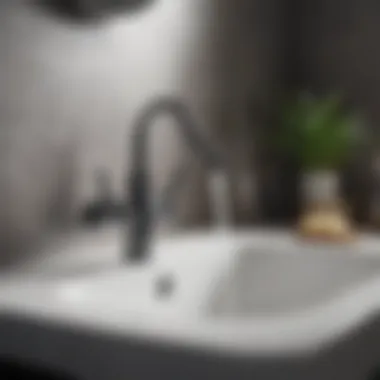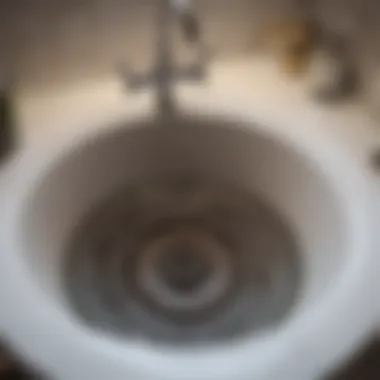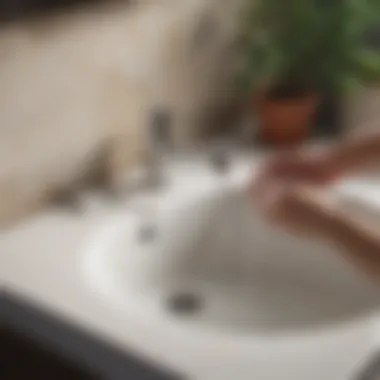Expert Guide: How to Clean Wash Basin Drain for Optimal Hygiene


Keeping your wash basin drain clean is essential to maintain hygiene and prevent clogs, ensuring smooth water flow in your bathroom or kitchen. Follow these detailed steps to effectively clean your wash basin drain and maintain a clean environment:
Preparation
Before starting the cleaning process, gather the necessary tools and materials. You will need a pair of rubber gloves, a plastic bucket, a drain cleaning brush, vinegar, baking soda, and hot water.
Removing Debris
Start by removing any visible debris or hair clogs from the drain. Use the drain cleaning brush to dislodge and remove blockages, ensuring that water can flow freely through the drain.
Vinegar and Baking Soda Solution
Mix equal parts of vinegar and baking soda to create a natural cleaning solution. Pour the solution down the drain and let it sit for about 30 minutes. The combination of vinegar and baking soda helps to break down grease and grime buildup.
Hot Water Flush
After allowing the vinegar and baking soda solution to work its magic, flush the drain with hot water. The hot water helps to wash away any remaining debris and ensures that the drain is clear and odor-free.
Regular Maintenance
To prevent future clogs, consider implementing a monthly maintenance routine for your wash basin drain. This can help you avoid major blockages and keep your drain clean and functional.


By following these simple yet effective steps, you can ensure that your wash basin drain remains clean and free of clogs, promoting a hygienic environment in your bathroom or kitchen.
Introduction
In the realm of household maintenance, ensuring the cleanliness of often-overlooked components like the wash basin drain is paramount. The accumulation of debris, hair, soap scum, and other residues can swiftly lead to blockages, impeding the smooth flow of water down the drain. Neglecting this essential task not only disrupts the functionality of your sink but also poses a hygienic risk. Picture a scenario where stagnant, grimy water remains stagnant due to a clogged drain - not a pleasing sight!
A clean wash basin drain facilitates efficient water drainage, preventing nasty odors from pervading your living space and minimizing the risks of overflow or plumbing mishaps. Imagine the annoyance of standing ankle-deep in murky water while trying to wash dishes or brush your teeth - surely not the serene environment one expects. Moreover, by heeding the advice on cleansing your wash basin drain, you steer clear of the costly hassle of enlisting professional plumbing services which could drain your finances unnecessarily.
Amidst the hustle and bustle of daily life, taking a moment to maintain the cleanliness of your wash basin drain yields long-term benefits. Not only does it uphold a more sanitized household environment, but it also ensures that daily tasks continue unimpeded. This guide serves as an invaluable resource in navigating the nuances of wash basin drain cleaning, enlightening you on practical DIY methods, preventive measures, and the significance of regular maintenance regimes.
Importance of Clean Wash Basin Drain
Ensuring the cleanliness and functionality of your wash basin drain is a crucial aspect of maintaining a hygienic environment in your bathroom or kitchen. A clean wash basin drain not only prevents unpleasant odors from permeating your space but also plays a significant role in preventing clogs and blockages. When water is unable to flow freely down the drain due to accumulated debris, it can lead to stagnant water and potential bacterial growth, posing health risks to occupants.
Moreover, a clean wash basin drain contributes to the overall aesthetics of your living space. A clogged or dirty drain can detract from the visual appeal of your bathroom or kitchen, creating an uninviting atmosphere. By regularly cleaning the wash basin drain, you can uphold the cleanliness and appeal of your living environment, making it a more pleasant and sanitized area for daily use.
In addition to the hygienic and aesthetic benefits, maintaining a clean wash basin drain also helps to preserve the longevity of your plumbing system. Blockages and clogs can put unnecessary strain on pipes and fittings, potentially leading to leaks or bursts if left unattended. By adopting regular cleaning practices and preventive measures, you can extend the lifespan of your plumbing infrastructure, saving you from costly repairs and inconvenience in the long run. Overall, the significance of a clean wash basin drain extends beyond just cleanliness, encompassing practical, aesthetic, and financial aspects that contribute to a well-maintained living space.
Tools and Materials Needed
When it comes to cleaning a wash basin drain effectively, having the right tools and materials is essential for ensuring a thorough job. Each item serves a specific purpose in combating clogs and maintaining optimal water flow. Without these tools, cleaning the drain becomes a challenging task, leading to potential blockages and unhygienic conditions.
Plunger


A plunger is a versatile tool that can help dislodge minor clogs in the wash basin drain. Its rubber cup creates a suction effect, which, when used correctly, can force the blockage to move and clear the pipe. When opting for a plunger, ensure it has a sturdy handle and a well-sealed cup to generate adequate pressure. Using a plunger is a cost-effective and environmentally friendly method compared to chemical cleaners.
Baking Soda
Baking soda is a natural cleaning agent that can help break down organic matter and neutralize odors in the wash basin drain. By creating a mixture of baking soda and water and allowing it to sit in the drain for some time, you can effectively loosen debris and buildup, making it easier to flush out. Baking soda is a non-abrasive solution that is gentle on pipes and environmentally friendly, making it a popular choice for drain cleaning.
Vinegar
Vinegar is another natural ingredient that serves as a powerful cleaning agent for wash basin drains. When combined with baking soda, vinegar creates a foaming reaction that helps dislodge stubborn blockages and sanitize the drain. Its acidic properties work well in breaking down greasy residues and mineral deposits, leaving the drain clean and odor-free. Vinegar is a versatile cleaner that can be used in various DIY cleaning solutions.
Wire Hanger
A wire hanger can be repurposed as a handy tool for removing debris or hair clogs from the wash basin drain. By straightening out the hanger and creating a small hook at one end, you can maneuver it into the drain to pull out accumulated gunk. The flexible yet sturdy nature of a wire hanger makes it ideal for reaching deep into the pipe and extracting material that may be causing a blockage. This simple yet effective tool can complement other cleaning methods for a more thorough drain maintenance routine.
Natural Methods for Cleaning
Maintaining a hygienic wash basin drain is imperative to prevent clogs and ensure optimal water flow. In this article, the focus is on natural methods for cleaning that not only effectively clear the drain but also avoid the harsh chemicals present in commercial cleaners. By opting for natural cleaning solutions, you not only contribute to a safer environment but also protect your plumbing system from potential damage caused by strong chemicals. Baking soda and vinegar are prominent natural ingredients known for their cleaning properties, making them ideal for drain maintenance.
Using Baking Soda and Vinegar
One of the most popular natural cleaning methods for wash basin drains involves using a combination of baking soda and vinegar. The reaction between these two household items creates a fizzing action that helps dislodge debris and grime from the drain pipes. To start, pour boiling water down the drain to loosen any substances clinging to the pipe walls. Then, sprinkle baking soda followed by vinegar into the drain. Allow the mixture to sit for at least an hour, or preferably overnight, to penetrate and break down the blockages. Finish by flushing the drain with hot water to wash away the loosened debris. This method serves as an eco-friendly and effective way to keep your wash basin drain clean and odor-free.
Plunging the Drain


Plunging is another natural method that can help clear minor clogs in the wash basin drain. It works by creating pressure that dislodges blockages, allowing water to flow freely again. Before plunging, ensure there is enough water in the sink to cover the bell of the plunger. Place the plunger over the drain opening and firmly push up and down for about 20-30 seconds. Repeat this action several times until the water begins to drain smoothly. Plunging is a simple yet powerful way to maintain your wash basin drain without resorting to harsh chemicals or professional help.
Chemical Drain Cleaners
Chemical drain cleaners play a crucial role in maintaining the cleanliness and proper functioning of your wash basin drain. These cleaners contain powerful chemicals specially formulated to dissolve stubborn blockages caused by grease, hair, soap scum, and other debris that can accumulate in the drain over time. One key benefit of using chemical drain cleaners is their ability to break down organic matter quickly, ensuring that water can flow freely through the pipes without any obstructions.
When considering the use of chemical drain cleaners, it is essential to follow the manufacturer's instructions carefully to achieve the best results. Ensure proper ventilation in the area when using these cleaners due to the strong chemicals they contain. Additionally, it is advisable to wear protective gloves and eye gear to prevent any contact with the skin or eyes.
It is worth noting that chemical drain cleaners are effective for moderate clogs but may not be suitable for severe blockages or older plumbing systems. In such cases, seeking professional plumbing assistance is recommended to avoid potential damage to the pipes. Remember to store chemical drain cleaners in a safe place, out of reach of children and pets, and follow proper disposal protocols to protect the environment.
Preventive Tips
Preventive tips play a crucial role in ensuring the longevity and functionality of your wash basin drain. By incorporating these simple yet effective practices into your regular maintenance routine, you can prevent pesky clogs and maintain optimal water flow in your bathroom or kitchen. One of the key preventive tips is to avoid pouring grease or oil down the drain as they can solidify and cause blockages over time. Regularly using a hair catcher is another preventive measure that can significantly reduce the likelihood of hair buildup in the drain. Additionally, implementing a monthly cleaning schedule using natural methods like baking soda and vinegar can help prevent odor and keep the drain free-flowing. By staying proactive and adopting these preventive tips, you can save yourself from the hassle of dealing with stubborn clogs and ensure a hygienic environment.
Regular Maintenance
Regular maintenance is essential for preserving the overall health of your wash basin drain. To effectively maintain your drain, it is recommended to flush hot water down the drain on a weekly basis to help dislodge any debris and keep the pipes clean. Inspecting the drain stopper regularly and removing any accumulated hair or debris can also prevent blockages and maintain smooth water flow. Furthermore, using a mild detergent to clean the drain stopper and surrounding areas can help prevent buildup and foul odors. Incorporating these simple yet effective maintenance practices into your routine can extend the lifespan of your wash basin drain and ensure efficient drainage for years to come.
Hair Catcher Usage
The usage of a hair catcher is a practical and effective way to prevent hair from clogging your wash basin drain. Hair catchers are small devices that fit over the drain opening and trap hair before it enters the pipes, reducing the likelihood of blockages. To effectively use a hair catcher, simply place it over the drain opening and clean it regularly by removing any trapped hair. Opt for a hair catcher with fine mesh to capture even the smallest hair strands and debris. By incorporating a hair catcher into your regular maintenance routine, you can minimize the risk of blockages caused by hair buildup and ensure the smooth flow of water down your wash basin drain.
Conclusion
The importance of properly cleaning a wash basin drain cannot be overstated. In this article, we have delved into the intricate details of maintaining hygiene and ensuring smooth water flow in your bathroom or kitchen through effective drain cleaning methods. By following the steps outlined in this guide, you can not only prevent clogs but also create a clean and healthy environment.
Clean wash basin drains not only contribute to the overall aesthetics of your space but also play a crucial role in promoting good sanitation practices. A clog-free drain leads to efficient water drainage, reducing the risk of water stagnation that can harbor harmful bacteria and unpleasant odors.
Additionally, regular maintenance of your wash basin drain can extend the lifespan of your plumbing system, saving you from costly repairs in the long run. By incorporating the natural cleaning methods and preventive tips discussed in this article into your routine, you can mitigate the risk of major drainage issues and ensure the uninterrupted functionality of your wash basin.



